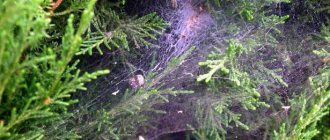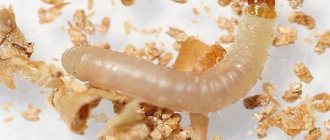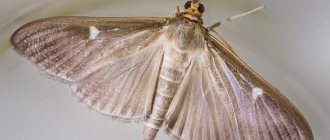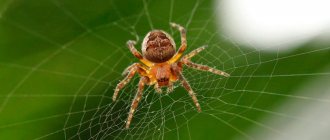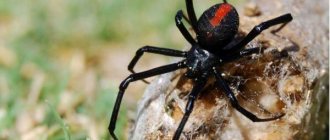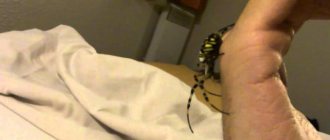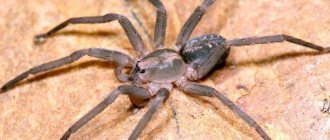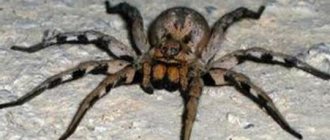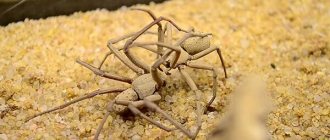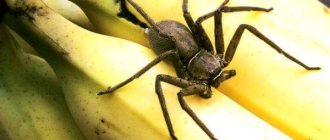What is a web?
Spiders are one of the oldest inhabitants of the planet; due to their small size and specific appearance, they are mistakenly considered insects. In fact, these are representatives of the order of arthropods. The spider's body has eight legs and two sections:
- cephalothorax;
- abdomen.
Unlike insects, they do not have antennae and a neck separating the head from the chest. The abdomen of an arachnid is a kind of factory for the production of cobwebs. It contains glands that produce a secretion consisting of protein enriched with alanine, which gives strength, and glycine, which is responsible for elasticity. According to the chemical formula, cobwebs are close to insect silk. Inside the glands, the secretion is in a liquid state, but when exposed to air it hardens.
Information. The silk of silkworm caterpillars and spider webs have a similar composition - 50% is fibroin protein. Scientists have found that spider thread is much stronger than caterpillar secretion. This is due to the peculiarity of fiber formation
The most famous “hunter” spiders
Digger spider (atypical tarantula)
Digger spider
Its name comes from the fact that it digs a hole in the soil and weaves a “web roof” over it, which even from a close distance looks like a small mound. As soon as the prey approaches this place, the spider rushes at it and drags it into its home.
Interesting: Why doesn’t the lynx turn white in winter?
The web spider (weaving a web) and its brother Karakurt (a type of black widow)
Karakurt spider
These spiders build their webs closer to the ground, using dry threads for this. Beacons are stretched at different edges of the network - sticky threads, like the rest of the web.
Ambush spider
The ambush spider
is distinguished by the fact that it does not weave or set up webs. It waits for prey, sitting in its web nest under tree bark or under cobblestones, attacking prey as it approaches.
Jumping spider
The jumping spider
is an atypical representative among its fellows. For hunting, he does not set up trap nets or make shelters. Seeing his prey even larger than himself, he pounces on it. He insures his jump by securing himself with a thread to the place of the jump.
Wolf spider
True to its name, it is active at night, constantly exploring the area in search of food.
Water spider (silver spider)
Water spider (silver spider)
Hunts from underwater shelters made of webs with air bubbles. In them he waits for the victim, occasionally surfacing for air.
https://www.youtube.com/watch?v=Om6um5YScME
Orb-weaving spider
Orb-weaving spider
A typical hunter that weaves webs. Its web has a completely template image - round, with rays diverging from the central part. The “Hunter” is in the middle, holding the thread with its paws, and monitors the situation. The signal from a special beacon indicates that an insect has fallen into a trap and indicates the place where this happened. The spider moves there and turns the prey into a lump, having first entangled it in a web.
Tree spider (a type of tarantula spider)
Tree spider
Found in the tropics, living in forests. It weaves a round web between the trees, reaching two meters in size, capable of withstanding a small bird and holding it, not to mention the insects it catches.
funnel web spider
Funnel spider
It is directly related to “ambushers”. It makes a nest in the shape of a funnel, secures it in stones, on fallen trees, in densely growing grasses. Being in the funnel, he waits for the victim, grabs it and pulls it towards him.
This is only a small part of all existing species of spiders, of which there are about forty thousand. Nature loves variety, as evidenced by the creation of a huge variety of arachnids.
Where does a spider's web come from?
On the abdomen of the arthropod there are outgrowths - arachnoid warts. In their upper part, the channels of the arachnoid glands open, forming threads. There are 6 types of glands that produce silk for different purposes (moving, lowering, entangling prey, storing eggs). In one species, all these organs do not occur at the same time; usually an individual has 1-4 pairs of glands.
On the surface of warts there are up to 500 spinning tubes that supply protein secretion. The spider spins its web as follows:
- spider warts are pressed against the base (tree, grass, wall, etc.);
- a small amount of protein adheres to the selected location;
- the spider moves away, pulling the thread with its hind legs;
- for the main work, long and flexible front legs are used, with their help a frame is created from dry threads;
- The final stage of making the network is the formation of sticky spirals.
Thanks to the observations of scientists, it became known where the spider’s web comes from. It is produced by movable paired warts on the abdomen.
Interesting fact. The web is very light; the weight of a thread wrapping the Earth along the equator would be only 450 g.
Spider sightings
After the ants, I suggest watching the spiders. If you are afraid of them, then it is better not to make such observations (and we looked at them very closely). I don’t really like them, but after my observations, I realized that spider webs are very beautiful!
Let's tell children about spiders
There are a great many different types of spiders on earth. Almost all of them are not dangerous to humans. All spiders are carnivores, with the exception of one species that feeds on plant foods. Spiders are not insects; spiders are a type of arthropod. Count the spider's legs, there are eight of them (while insects have six). The spider's body consists of two parts. The spider has arachnoid warts on its abdomen; they release liquid, which, like glue, hardens in the air, forming a thread. All spiders weave webs. Moreover, each spider has its own type of web. In most cases, the spider has 8 or 6 eyes (that's why it sees you so well). With the help of a web, a spider catches its prey, usually insects. Then he injects poison into them (the victim softens, the insides turn into a nutrient solution), after several hours the spider sucks out the victim. Spider web is a very durable material; in addition, it is sticky (covered with droplets of glue). But how then does the spider move along it and not stick? The fact is that the spider’s legs have hairs, so the leg does not come into contact with the glue; the spider literally glides along the web “on tiptoe.” Spiders need webs not only for catching prey. Young spiders use webs as a means of transportation. During the Indian summer, you can see many threads of cobwebs flying in the air. Small spiders are attached to the ends of such a thread. This is how the hatched spiders spread throughout the world. In addition, the web also serves as a nest for spiders, and spiders also lay eggs in the web (the web is a cradle).
Observations on a walk
Invite your child to look for spiders and cobwebs. Take photos of your finds. There are many types of webs, that is, they are not all the same. Most likely you can find a round web, single threads of a web, a chaotic labyrinth of a web (or a shapeless canvas), cocoons. By the way, we had spiders everywhere, just have time to notice them. But they are so fast! Taking a photo is a big problem, they immediately hide. Here is one of many, hurrying somewhere:
And we also found different webs. The most common type is a chaotic labyrinth. This shapeless fabric is most often woven by house spiders. Cobwebs are easy to see on outbuildings. But there are also a lot of cobwebs in the grass. In our garden, spiders have taken a fancy to lilies of the valley. There are a lot of cobwebs there.
And in the meadow, small spiders weave webs in the grass. Apparently they hunt small insects. There's a spider lurking in the middle:
If you touch the web with your finger, you will feel that it is sticky. By the way, here you need to ask the child why the web is sticky. On walks we often use finds. They develop observation skills. Our find can be downloaded from the link at the end of the article. Here are our finds (we had to find a spider and a cobweb, a yellow flower, moss and a stick that looked like someone):
What questions can be discussed during a walk?
- Why does a spider weave a web? — why is the web sticky (touch it)? — who does the spider hunt? - why doesn’t the spider stick to the web (your assumptions)? - How does a spider kill its victim? - How is a spider useful?
Please note that if the spider does not spread its webs, it is a sign of cold weather. And vice versa.
During our walk we were lucky to see the hunting process firsthand. A beetle got caught in the spider's net. It was very interesting to watch. It immediately became clear why the web was sticky: the beetle could not get out. And the spider was right there. He did two things at once: he bit his victim and entangled him even more in his web. It was amazing, very exciting! Look, here he sneaks up and stings, the victim resists, she is alive:
And this is 3 hours later, the spider is eating, the victim has not moved for a long time:
Games at home
We played two games. I tied ropes around the sports complex, and we played spider and its victim (switched roles). The game is active. The victim's task was not to get entangled in the web (not to touch it), otherwise the spider would come running. The second game, “Catch a Fly in the Web,” is also action-packed. We make a web in the doorway by pulling the tape (sticky side towards the player). Then we throw crumpled paper (these are “flies”) into the web. Some of the flies will stick to it. In this game you can clearly see that the web is sticky.
At home, you can tell a fairy tale based on the Eric Carle fairy tale “Very Busy Spider.” In the process of telling the story, I weaved a web for a spider on a disposable plate. The meaning of the tale is that the spider was very busy, he was weaving a web. And the pets took turns coming up to him and inviting him to play. But the little spider was very busy and did not even answer them. In the end, the spider did its job and caught the fly in its web, so its work was also useful. The fairy tale is easy to dramatize (the text of the fairy tale is in the file with tasks).
You can download the assignments and find from this link. After all these observations of spiders, Semyon enthusiastically told his dad how a spider ate a beetle, and also wrapped ropes around the room (“spun a web”) and pretended to be a spider) Spiders clearly became closer to his son. Yes, and I must admit, too.
How to build a fishing net
The wind is the spider's best assistant in construction. Having taken out a thin thread from the warts, the arachnid exposes it to an air flow, which carries the frozen silk over a considerable distance. This is the secret way a spider weaves a web between trees. The web easily clings to tree branches, using it as a rope, the arachnid moves from place to place.
A certain pattern can be traced in the structure of the web. Its basis is a frame of strong and thick threads arranged in the form of rays diverging from one point. Starting from the outer part, the spider creates circles, gradually moving towards the center. It is amazing that without any equipment it maintains the same distance between each circle. This part of the fibers is sticky and is where insects will get stuck.
Interesting fact. The spider eats its own web. Scientists offer two explanations for this fact - in this way, the loss of protein during the repair of the fishing net is replenished, or the spider simply drinks water hanging on the silk threads.
The complexity of the web pattern depends on the type of arachnid. Lower arthropods build simple networks, while higher ones build complex geometric patterns. It is estimated that the female crosstail builds a trap of 39 radii and 39 spirals. In addition to smooth radial threads, auxiliary and catcher spirals, there are signal threads. These elements capture and transmit to the predator the vibrations of the caught prey. If a foreign object (a branch, a leaf) comes across, the little owner separates it and throws it away, then restores the net.
Large arboreal arachnids pull traps with a diameter of up to 1 m. Not only insects, but also small birds fall into them.
The role and significance of the web in the life of a spider
Undoubtedly, spiders primarily need webs to hunt. The woven network contains insects, which constitute the main diet of arachnids. But the web is not only a means of catching prey. In the life of spiders, it performs many different functions:
- Creation of a cocoon. The female weaves strong and comfortable cocoons from the web, in which she lays eggs. After hatching, the little spiders spend the first weeks of their lives in this cocoon, feeling completely protected from the external environment and enemies.
- Shelter. The web allows the arthropod to take shelter from bad weather and hide from enemies.
- Reproduction. Depending on the species, the female or male uses the thread of the web to attract the attention of the opposite sex. Either the male attaches his thread to the female’s network, informing her of his intentions, or the female secretes a thread impregnated with pheromones, by which she can be easily found.
- Vehicle. The strong and elastic structure of the spider web thread makes it an excellent means of transportation. With its help, spiders can move between trees or bushes, and even fly long distances, clinging to a web carried by a gust of wind.
- Protection. Some types of spiders use webs to glue debris together and make a dummy that looks like a spider. In case of danger, they pull the thread, the dummy moves, the predator is distracted, and the spider manages to leave the dangerous place.
Some aquatic species of spiders have air in their web sac, which allows them to stay underwater.
Purpose of the web
Fine nets are not only insect traps. The role of the web in the life of arachnids is much broader.
Catching prey
All spiders are predators, killing their prey with poison. Moreover, some individuals have a fragile constitution and can themselves become victims of insects, for example, wasps. To hunt, they need shelter and a trap. Sticky fibers perform this function. They entangle the prey caught in the net in a cocoon of threads and leave it until the injected enzyme brings it into a liquid state.
Arachnid silk fibers are thinner than human hair, but their specific tensile strength is comparable to steel wire.
Reproduction
During the mating period, males attach their own threads to the female's web. By striking the silk fibers rhythmically, they communicate their intentions to a potential partner. The female receiving courtship descends onto the male’s territory to mate. In some species, the female initiates the search for a partner. She secretes a thread with pheromones, thanks to which the spider finds her.
Home for posterity
Cocoons for eggs are woven from the silky web secretion. Their number, depending on the type of arthropod, is 2-1000 pieces. The females hang the web sacs with eggs in a safe place. The cocoon shell is quite strong; it consists of several layers and is impregnated with liquid secretion.
In their burrow, arachnids weave webs around the walls. This helps create a favorable microclimate and serves as protection from bad weather and natural enemies.
Moving
One of the answers to why a spider weaves a web is that it uses threads as a vehicle. To move between trees and bushes, quickly understand and fall, it needs strong fibers. To fly over long distances, spiders climb to elevated heights, release a quickly hardening web, and then with a gust of wind they fly away for several kilometers. Most often, trips are made on warm, clear days of Indian summer.
How do spiders weave such large webs?
A Danish scientific magazine asked an entomologist how spiders manage to weave such large webs. It turns out that they are real masters of engineering: spiders not only work every day on complex structures, but also come up with the most ingenious and insidious traps. How do spiders weave such large webs?
To answer the question, we turned to Sebastian Frische, a lecturer at the Institute of Biomedicine at Aarhus University.
Sebastian Frische studies webs exclusively, and he explained to us that a spider begins to weave its web (if it is a circular web - but more on that later) with one thread, which is called the “web bridge”.
For example, when the spider needed to weave a web across the path along which Susanna was walking, he sat down on the branches on one side of the path, his butt upside down with a piece of silk thread.
He waited for the wind to pick up the thread and pull it further and further until it was fixed on some branch on the other side of the path.
This is how the first “bridge” stretches over long distances.
“When spiders fly, they do the same thing. They allow the wind to catch a piece of the web, and then release the branch they are sitting on. In this way, spiders can fly over distances of many kilometers,” says Sebastian Frische.
Weave a web without glue
When the first thread across the path was stretched, the spider reinforced it with several more threads. And only after that did he begin to weave the frame, which eventually became the outer edge of the web.
The spider begins by pulling a thread from the middle of the “bridge” to a support point - this could be some other branch - and then connects three points with threads, forming a triangle.
Having created the frame, he begins to stretch the “spokes” from the middle of the network to the edges, as if it were a bicycle wheel.
It then forms a stabilizing spiral from the middle of the network to the edges - across the “spokes”.
“So far, the spider has used a completely ordinary type of silk web, without any glue. All this is needed to create a rigid frame for the web, with which it will catch insects,” says Sebastian Frische.
Different spiders weave different webs
Having created a stable base for its web, the spider crawls into its middle and begins to weave a spiral of adhesive silk from the center to the edges.
The spider carefully steps so as not to touch the adhesive threads: it only walks along ordinary ones. Otherwise, he himself may get stuck.
Along the way, the spider removes the temporary spiral until only the sticky spiral and non-sticky stabilizing “spokes” remain on the web.
Finally the spider settles down in the center and tightens the threads a little here and there to create the correct tension throughout the web.
Here is the spider's net and is ready to catch flies - or Susanna.
“Usually the spider sits in the center of the web, waiting for a fly or something like that to get into it. But some spiders sometimes sit to the side, keeping one paw on the “signal thread”, which twitches if someone gets caught in the web. Different types of spiders behave differently,” explains Sebastian Frische.
Crossers weave a new web every day
The most common Danish crossmaker spends an hour and a half in the morning weaving a net with a diameter of about 20-30 centimeters.
However, the web quickly breaks, and within a day the spider has to re-weave the adhesive part.
Other spiders weave webs in the evening to catch insects at night or in the morning.
Prey is wrapped in a third type of web
Spiders use different types of webs for different purposes. We have already mentioned adhesive and non-adhesive threads, but there is a third variety.
If someone gets caught in a spider's web, the spider crawls to the prey and wraps it in a completely different - third type of web. This time he uses many thin threads, which he releases very quickly - before the prey runs away.
“These are special silk threads, their advantage is that the spider can cover a large area with them in a short time,” says Sebastian Frische.
Well, then, unfortunately for the caught insect, the spider quickly bites it and pumps it full of poison. The venom contains enzymes that slowly dissolve the prey so that the spider can suck it out like an egg from its shell.
Throw webs at prey
Different types of spiders use their webs differently.
Bolas spiders use webs as throwing weapons.
When a bolas wants to catch prey, it releases a long thread with a wad of glue at the end.
He waves a ball of glue around, trying to hit, for example, a night moth, and if he succeeds, he pulls the victim towards him and wraps him in a web, as if he were wrapping a lunch box in paper.
Making traps from spider webs
There are no bolas spiders in Denmark, but there are other types of spiders (steatodes) that weave so-called glue traps - no less impressive.
A glue trap consists of a horizontal web of web located approximately five centimeters above any surface. Between the canvas and the surface, the spider stretches several thin threads with a lump of glue at the base.
If, for example, an ant comes under the net and touches one of these threads, the trap will work - the thread with a lump of glue in which the ant is stuck will rise up, and he will be suspended.
“He will hang out there until the spider arrives,” explains Sebastian Frische.
